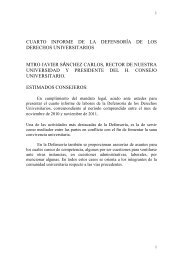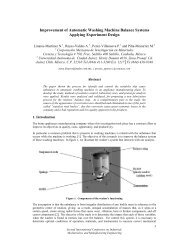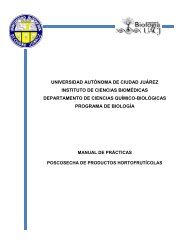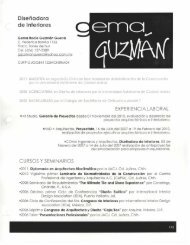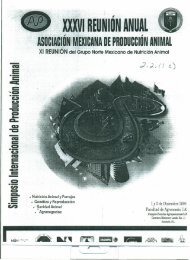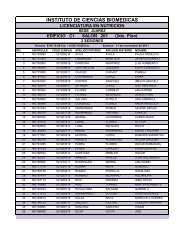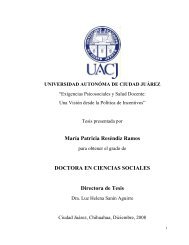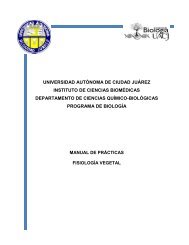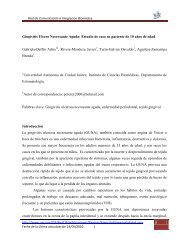journal of computers issn 1796-203x - Universidad Autónoma de ...
journal of computers issn 1796-203x - Universidad Autónoma de ...
journal of computers issn 1796-203x - Universidad Autónoma de ...
Create successful ePaper yourself
Turn your PDF publications into a flip-book with our unique Google optimized e-Paper software.
JOURNAL OF COMPUTERS, VOL. 4, NO. 8, AUGUST 2009 701<br />
VI. HYBRID DISCRETE EVENT CONTROLLER FOR PROPER<br />
DECISION MAKING<br />
In the presence <strong>of</strong> job sequencing conflicts in<br />
manufacturing cells, the Petri Net tool itself provi<strong>de</strong>s<br />
through the enabled transitions the possible firing <strong>of</strong> jobs<br />
that are in conflict for particular resources. Refer to figure<br />
4, showing a simplified PN example for further problem<br />
<strong>de</strong>finition. Since for this case enabled transitions r2•, put<br />
in conflict to resource r2, a <strong>de</strong>cision must be ma<strong>de</strong> and<br />
<strong>de</strong>ci<strong>de</strong> which <strong>of</strong> the resources/buffers r1 or r3 should be<br />
released.<br />
By controlling the marking on vector uc, only one<br />
transition from the set <strong>of</strong> conflicted transitions can be<br />
fired (i.e. leaving only one token in either uc1 or uc2.) This<br />
<strong>de</strong>cision could be ma<strong>de</strong> based on the preference on the<br />
resource to be released, but also on the preference <strong>of</strong> the<br />
part to be released among all parts from places v1 and v3.<br />
In large manufacturing processes, including<br />
Semiconductor manufacturing processes, this <strong>de</strong>cision is<br />
ma<strong>de</strong> based on parts/wafers, and its attributes. This<br />
means that it is <strong>de</strong>sired to inclu<strong>de</strong> more information in the<br />
marking vector, m(t) (5), since not only the number <strong>of</strong><br />
‘tokens’/parts per buffer, or job, are important, but also<br />
the in<strong>de</strong>pen<strong>de</strong>nt attributes <strong>of</strong> parts such as arrival time to<br />
the cell, cost, waiting time, and its expected end <strong>of</strong><br />
process time.<br />
u 1 v 1 o 3<br />
u c1 r 2<br />
u c2<br />
v 3<br />
u 2 v 4 o 2<br />
Figure 4. Petri Net structure with conflict in r 2.<br />
Then, it is required that all part attribute information must<br />
be conserved and maintained on each element <strong>of</strong> v(t) T , the<br />
pending or finished jobs <strong>of</strong> the entire cell. This can be<br />
easily maintained by enhancing this vector through<br />
v(t,k) T , where k stands for the k th part in the set <strong>of</strong> parts<br />
for each resource job vector v(t) T . For example.<br />
Consi<strong>de</strong>ring figure 4, the marking in that state t <strong>of</strong> this<br />
PN for job v1 is three (each job type vk(t) is a member <strong>of</strong><br />
v(t) T .) Then, each part in vk(t) can be particularized<br />
though v(t,k), since<br />
vj(t) = U vj(t,k) = { vj(t,1), vj(t,2), …, vj(t,n)}, (7)<br />
where n is the number <strong>of</strong> parts in job or buffer vj(t).<br />
Then, we propose that our main DE Supervisor be<br />
divi<strong>de</strong>d as shown in figure 5. The main planner <strong>de</strong>ci<strong>de</strong>s<br />
on the system supervisor structure <strong>of</strong> matrix formulation,<br />
creating indirectly the entire PN system structure. Then,<br />
the matrix controller structure calculates the task or state<br />
logic vector, (1), which <strong>de</strong>termines the possible firing <strong>of</strong><br />
jobs <strong>of</strong> resources.<br />
© 2009 ACADEMY PUBLISHER<br />
r 1<br />
r 3<br />
v 2<br />
In case <strong>of</strong> any conflict on jobs, a conflict resolution<br />
engine takes its <strong>de</strong>cision based on the attributes <strong>of</strong> the<br />
parts which uses a fuzzy logic approach. This engine<br />
might consi<strong>de</strong>r intelligent <strong>de</strong>cision making by combining<br />
different standard conflict resolution rules, and by<br />
consi<strong>de</strong>ring each attribute <strong>of</strong> parts in conflicted buffers.<br />
In this work, in or<strong>de</strong>r to <strong>de</strong>monstrate the performance <strong>of</strong><br />
the cell, we combined the following resolution<br />
techniques: FIFO, LS, EDD, and SRPT.<br />
Figure 5. Hybrid discrete Event Supervisor and Conflict<br />
Resolution Agent<br />
In or<strong>de</strong>r to <strong>de</strong>fine the way we combine these resolution<br />
techniques, consi<strong>de</strong>r the following <strong>de</strong>finitions:<br />
1) <strong>de</strong>fine Resol( type , vj(t) ), as the conflict resolution<br />
type technique to be applied to all<br />
available/machined parts in vj(t). The outcome <strong>of</strong> this<br />
function is the set<br />
[vj(t,k), w], (8)<br />
where vj(t,k) is the part that conflict resolution type<br />
opted, and w is the percentage weight that this<br />
conflict resolution routine weighted the part vj(t,k)<br />
over the others.<br />
2) <strong>de</strong>fine Conflict( rj(t) ), as the function that returns the<br />
set <strong>of</strong> jobs {vj(t)} in conflict with this resource (this<br />
is a row vector). (9)<br />
Then, for each machine rj(t) we calculate the matrix<br />
Resol( type , Conflict(rj(t)) ) T . For the r2 resource from<br />
our conflict example, this matrix has the following<br />
format:



